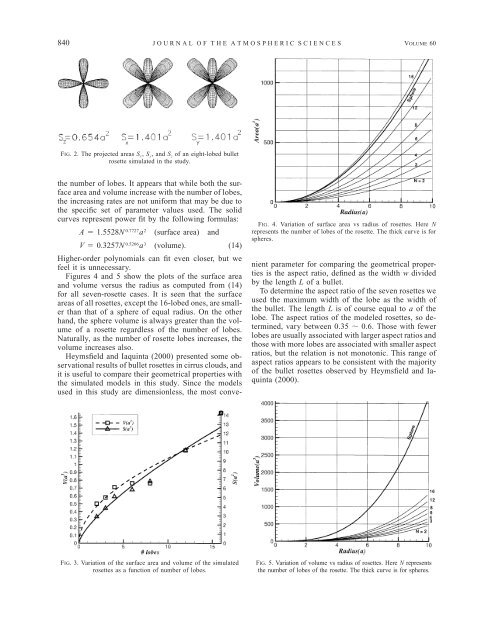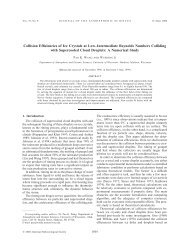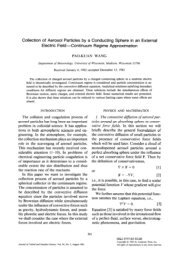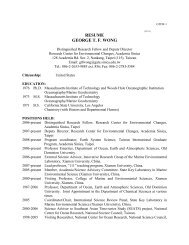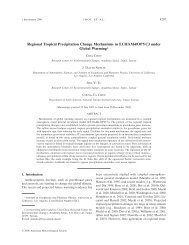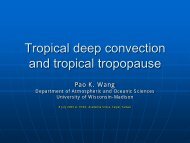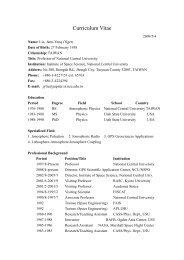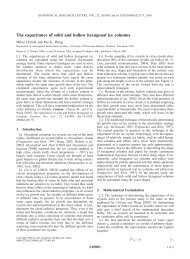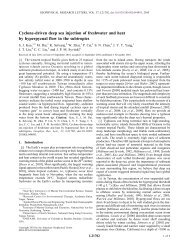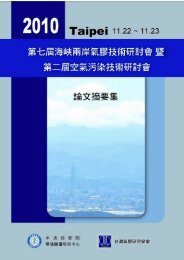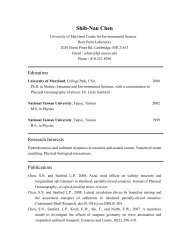The Capacitance of Rosette Ice Crystals - University of Wisconsin ...
The Capacitance of Rosette Ice Crystals - University of Wisconsin ...
The Capacitance of Rosette Ice Crystals - University of Wisconsin ...
You also want an ePaper? Increase the reach of your titles
YUMPU automatically turns print PDFs into web optimized ePapers that Google loves.
840 JOURNAL OF THE ATMOSPHERIC SCIENCES<br />
VOLUME 60<br />
FIG. 2. <strong>The</strong> projected areas S x , S y , and S z <strong>of</strong> an eight-lobed bullet<br />
rosette simulated in the study.<br />
the number <strong>of</strong> lobes. It appears that while both the surface<br />
area and volume increase with the number <strong>of</strong> lobes,<br />
the increasing rates are not uniform that may be due to<br />
the specific set <strong>of</strong> parameter values used. <strong>The</strong> solid<br />
curves represent power fit by the following formulas:<br />
0.7727 2<br />
A 1.5528N a (surface area) and<br />
FIG. 4. Variation <strong>of</strong> surface area vs radius <strong>of</strong> rosettes. Here N<br />
represents the number <strong>of</strong> lobes <strong>of</strong> the rosette. <strong>The</strong> thick curve is for<br />
spheres.<br />
0.5206 3<br />
V 0.3257N a (volume). (14)<br />
Higher-order polynomials can fit even closer, but we<br />
feel it is unnecessary.<br />
Figures 4 and 5 show the plots <strong>of</strong> the surface area<br />
and volume versus the radius as computed from (14)<br />
for all seven-rosette cases. It is seen that the surface<br />
areas <strong>of</strong> all rosettes, except the 16-lobed ones, are smaller<br />
than that <strong>of</strong> a sphere <strong>of</strong> equal radius. On the other<br />
hand, the sphere volume is always greater than the volume<br />
<strong>of</strong> a rosette regardless <strong>of</strong> the number <strong>of</strong> lobes.<br />
Naturally, as the number <strong>of</strong> rosette lobes increases, the<br />
volume increases also.<br />
Heymsfield and Iaquinta (2000) presented some observational<br />
results <strong>of</strong> bullet rosettes in cirrus clouds, and<br />
it is useful to compare their geometrical properties with<br />
the simulated models in this study. Since the models<br />
used in this study are dimensionless, the most convenient<br />
parameter for comparing the geometrical properties<br />
is the aspect ratio, defined as the width w divided<br />
by the length L <strong>of</strong> a bullet.<br />
To determine the aspect ratio <strong>of</strong> the seven rosettes we<br />
used the maximum width <strong>of</strong> the lobe as the width <strong>of</strong><br />
the bullet. <strong>The</strong> length L is <strong>of</strong> course equal to a <strong>of</strong> the<br />
lobe. <strong>The</strong> aspect ratios <strong>of</strong> the modeled rosettes, so determined,<br />
vary between 0.35 0.6. Those with fewer<br />
lobes are usually associated with larger aspect ratios and<br />
those with more lobes are associated with smaller aspect<br />
ratios, but the relation is not monotonic. This range <strong>of</strong><br />
aspect ratios appears to be consistent with the majority<br />
<strong>of</strong> the bullet rosettes observed by Heymsfield and Iaquinta<br />
(2000).<br />
FIG. 3. Variation <strong>of</strong> the surface area and volume <strong>of</strong> the simulated<br />
rosettes as a function <strong>of</strong> number <strong>of</strong> lobes.<br />
FIG. 5. Variation <strong>of</strong> volume vs radius <strong>of</strong> rosettes. Here N represents<br />
the number <strong>of</strong> lobes <strong>of</strong> the rosette. <strong>The</strong> thick curve is for spheres.


